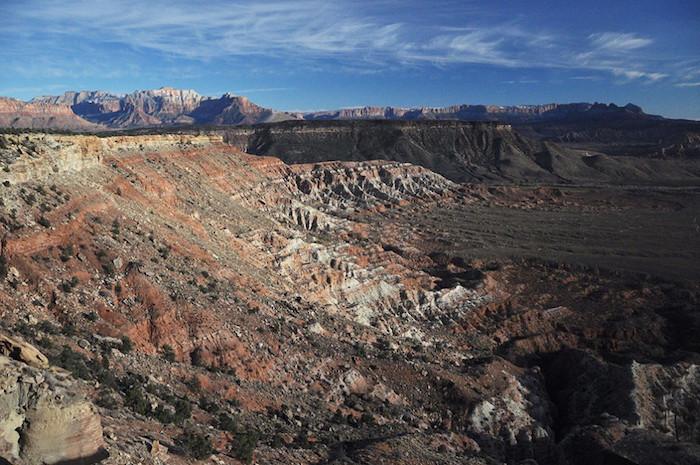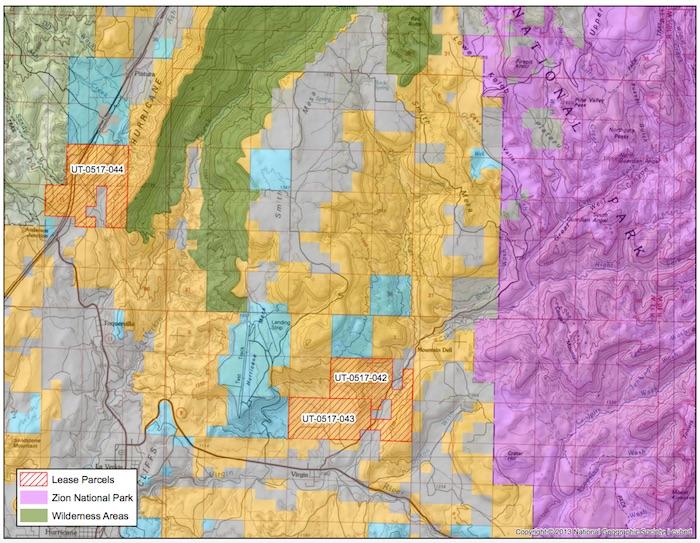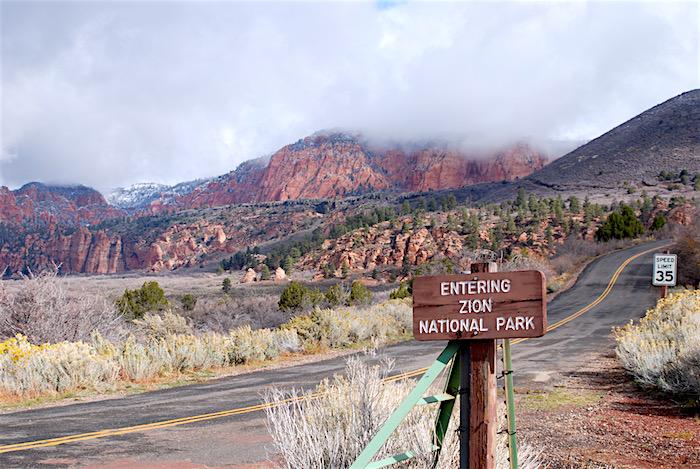
This landscape, part of the Dry Creek proposed wilderness near Zion National Park, is being considered for oil and gas leasing by the U.S. Bureau of Land Management/copyright Luke Henry/SUWA
Just two weeks into the Trump administration, one pledged to pursue a vigorous domestic energy development course, Zion National Park officials find themselves in a bind over how to react to a proposal to allow oil and gas exploration within a mile of the park.
With U.S. Rep. Ryan Zinke's confirmation as Interior secretary yet to be finalized by the Senate, park officials are waiting for him to take the helm at Interior and seek his guidance on the matter.
“It’s a real peculiar time to be making hard statements one way or another with the transition of administrations," said Zion spokesman John Marciano. "It's a sensitive topic."
At issue is the possibility that the U.S. Bureau of Land Management will put up for an oil and gas lease auction in June three parcels near the park in southwestern Utah, including one that would straddle the Kolob Terrace Road north of Virgin that is used to reach the "roof" of the park. The agency is taking comments through Friday on an environmental assessment analyzing the consequences of putting the parcels up for auction, though the National Park Service is thinking of asking the BLM to extend the comment period.
"We’re writing a letter to BLM to ask them to extend the comment period so we can further review with senior leadersjhip and further obtain more current geological statistics from various services that will affect how we’ll respond," said Mr. Marciano late last week. "We want to get more information. We want to support our statements with better statistics.
"... Until further analysis of the EA is done, which will include obtaining more up-to-date statistics from various departments and conversations with senior leadership, we really can't respond to having a particular position," he added. "We are, however, concerned with protections under the Clean Air Act as Zion is considered a Class 1 area; the affect of noise, erosion, and with protecting the darkness of the night sky."

This locator map shows the proximity of three parcels being considered for oil and gas leasing to Zion National Park/SUWA
National Parks Conservation Association officials have been more vocal in opposing the potential auction, saying drilling isn't appropriate so close to the national park.
“We’re concerned about air quality, night skies, soundscapes," said Cory MacNulty, NPCA's senior program manager for Utah. “We are also concerned about the impact on visitor experience. We feel not only is this not in an appropriate location, but they’re being offered for lease at a very critical time with increased visitation to Zion.”
Zion has seen a sizeable increase in visitation, with last year's tally of 4,317,028 representing a nearly 18 percent increase over 2015 numbers. The park's heightened popularity has officials working on a visitor use management plan, one that might call for a carrying capacity to be established. With shoulder seasons getting shorter and shorter, NPCA officials are concerned about the impact drilling activity could have on those trying to enjoy the park.
With at least one of the parcels being located in critical winter habitat for mule deer, any successful leasee likely would have to concentrate their drilling operations during the busy tourist season, said Ms. MacNulty.
"The bottom line for us," she said, "is there aren’t producing wells in the county. This is not an appropriate place to start, a mile from Zion National Park. The national park is drawing visitors from around the world, and we’re grappling with that visitation now. Given the importance of the park to the economy and the future of the area, we don’t think this is an appropriate location."
Louise Excell, an area resident, spoke out against the proposal in January.
“As a lifetime resident and a retired owner of several hospitality and tourist-related businesses in Springdale, Utah, I know how crucial the greater Zion National Park area is to our visitors and local residents alike,” she said. "I cannot imagine how visitors will feel as they discover pump jacks and flares from oil and gas drilling are visible from both inside and outside the park. Not only will the sight be jarring for visitors and residents, but other important natural resources and quality of life will be affected, including diminished air quality, loss of natural soundscapes, and night skies.”

An oil and gas lease could straddle the Kolob Terrace Road that runs from Virgin into Zion National Park if the BLM puts a parcel of land up for auction in June/Kurt Repanshek
Officials with the Southern Utah Wilderness Alliance see no need for the parcels to be put up for auction.
"The oil and gas industry has roughly 2 million acres of BLM-managed lands in Utah already under lease that they have not developed," the advocacy group said. "Despite the extensive leased lands, in 2016 the drilling of new oil and gas wells in Utah reached a 30-year low."
“BLM’s proposal to sell these two leases is déjà vu all over again. Just like its proposal in 2008 to sell leases adjacent to Arches and Canyonlands National Park and Dinosaur National Monument, this is an entirely ill-conceived plan that should be rejected,” said Landon Newell, SUWA's staff attorney. “This lease-first, think-later approach to oil and gas leasing has been rejected time and time again. It’s hard to understand what would compel BLM to propose offering these parcels but whatever their motivation, BLM should rethink its proposal which threatens Utah’s most popular national park.”
Traveler footnote: A petition asking the BLM not to put the parcels up for auction can be found at this page.



Comments
I agree tomp2, thank you for the post.
Is the entire length of the Salt Creek Road in environmentally sensitive areas? Given that the road was in bad condition then why is it not possible to repair the road? Maybe there is a way to place the road where it avoids the sensitive areas. Some visitors do not have the energy or the time to hike the approximately 20 miles to the arch. Maybe there could be an extension of a road from another area to make it more accessible. Canyonlands National Park - Needles District has lots of long hikes but very few moderate day hikes (10 miles and under). Most hikes there require almost a full day or an overnight trip for the average visitor.
Maybe it time to evolve the park. Put roads and hiking trails in places that have not had them before. I see other parks doing road construction. Why could this not be done to Salt Creeek Road or portions of the Salt Creek Road to allow more access to all visitors?
As is the case with many "roads" in Utah, the Salt Creek "road" is actually a live stream for almost all of its length. It never has been a real road.
I think in some cases trails need to be better organized. For example in Arches National Park there is an informal hike to Ring Arch. Really overgrown and I never saw the Arch close up. Saw it from a distance but too much brush to get through to get close. How much damage did I do considering there was no trail? No sign. Wouldn't hikers do less damage with a formal trail instead of guessing at where they think the trail should be?
I would like to see the Park Service do guided ranger hikes to Angel Arch. Just like they offer in the Fiery Furnance. If the 20 miles is as easy as people are saying then the Park Service should have no trouble leading this hike. Have it start in the morning and end in the afternoon if it is as accessible as some here are suggesting.
The simple fact is that there has been roads in the area for many years and several years ago people decided that there should not be a road anymore. I have often wondered what would happen if access to Angel Arch came from the south. Would there be less disturbance to the environment coming into the park from the south.
So if you have unlimited time and energy you can visit Angel Arch. I plan almost all of my family's trips. Right now to visit Angel Arch I would have to allow one full day to visit it. Others would suggest that you have to camp to get there. 2 days then just to visit this arch. Sorry if I believe that maybe the Park Service can do better than this.
Odd that some people are talking about preserving Salt Creek and access to Angel Arch for future generations since its access is currently restricted to the current generation. Right now the majority of the current visitors to Canyonlands National Park cannot see this area because somebody decided that it would be best to eliminate the roads in the area. The people making this decision were extremely narrow-minded people. Upgrading the road could not happen. Some here comment on people getting stuck. Guess putting a ranger station on some part of that road would be out of the question. Somebody who could notify others when people get stuck. Somebody who could maybe have access to equipment to get out of ditches.
Just close off the area. That was the only thing considered. We keep restricting people to certain parts of our national parks but yet we are puzzled about why they are crowded. In this case people could be spread out in the Salt Creek Area. What's next? Close the parking area where all the cars are supposed to park because there are fumes from the cars in the area
Seeing this area became more difficult and inaccessible to the majority of the public when this area was closed to visitors. Of course it is a level 20 round-trip. If you have several days to spare then you should be able to make it. Sad that the Park Service wants to hide this landmark and restrict access to it. How many visitors have missed seeing this landmark because of this decision?
I'd really like to know what the park service is not publishing any information on the proposoed oil drilling in and aroiund our parks. Please do the world population and inform.
http://www.nationalparkstraveler.com/2017/02/change-administrations-puts...